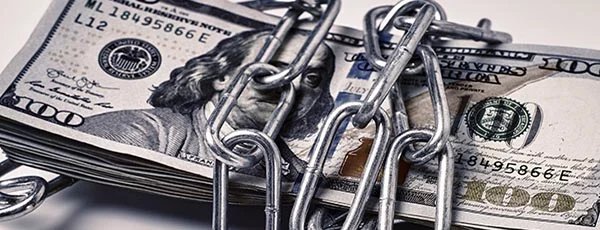How to Open a Bank Account That No Creditor Can Touch

- Creditors can, in some cases, take money from your bank account. It’s called a levy or garnishment.
- Most creditors must sue you and win a judgment to levy your bank account.
- Separating protected income could shield your money from a bank account levy.
Table of Contents
- What Is a Bank Account Levy?
- How Does a Bank Account Levy Work?
- Four Strategies to Open a Bank Account That No Creditor Can Touch
- Can Creditors Levy Your Bank Account Without Telling You?
- How Much Can Creditors Take With a Bank Account Levy?
- How Often Can a Bank Account Levy Happen?
- What Types Of Bank Accounts Can Be Levied?
- What To Do If Your Bank Account Is Levied
- Can You Hide Bank Accounts From a Bank Account Levy?
A bank account levy (sometimes called bank garnishment) is when creditors take money from your bank account to settle debts you owe. This typically requires that a creditor sues you, wins, and gets a court judgment.
Once a levy is issued and given to the bank, your bank could freeze your account, allowing deposits but blocking withdrawals.
You can take steps to shield your funds from a bank account levy.
What Is a Bank Account Levy?
A bank account levy is when creditors legally take funds from your bank account to pay a debt, usually after winning a court judgment against you. The term "garnishment" is sometimes used, but it more often applies to wages. "Levy" and “attach” are more specific to bank accounts.
Certain institutions, like the IRS, can apply a levy without a court order, but it typically doesn’t happen before you’re notified. When levied or attached, your account is frozen, restricting access to your money.
How Does a Bank Account Levy Work?
Most creditors follow these steps to levy your bank account:
File a lawsuit to prove you owe the debt.
Get a judgment by winning the case (note: If you don’t appear in court, the creditor wins automatically).
Request a levy order from the court.
Deliver the order to your bank, which freezes your account.
Exceptions to this process exist. The IRS and U.S. Department of Education are allowed to levy without a court order for tax or student loan debts, respectively, but must provide notice. If you default on a loan with your bank or credit union, they could use something called the "right of offset" to take funds from your bank account without telling you first.
What happens during a bank account freeze?
When creditors levy your bank account, your account is frozen. You can deposit money, but withdrawals are blocked. Checks could bounce, triggering fees. Some states allow limited access to funds for essentials like rent or food. You have to request this in court unless your state is among those that automatically protect a portion of your balance.
Four Strategies to Open a Bank Account That No Creditor Can Touch
Provided you haven’t been levied yet, the following four strategies can help protect your funds.
1. Keep your money in a qualified retirement account
Federal law shields qualified retirement plans such as 401(k) and 403(b) accounts from creditors. Individual retirement accounts (IRAs) lack federal protection, but some states exempt them from a bank account levy. Check your state’s regulations to confirm.
2. Open state-protected accounts
Certain states offer accounts protected from a bank account levy:
Tenancy by Entirety accounts: Available in states like Florida, these joint accounts for married couples may be safe from creditors when only one spouse owes the debt.
Exempt fund accounts: Some states protect a small balance. For example, New York shields $1,716 in some situations.
Research your state’s laws or talk to an attorney for options.
3. Use dedicated accounts for federal income
Income exempt from a bank account levy includes:
Government benefits: Federal payments like Social Security, veterans benefits, and military pay (protected under federal law)
Child support: Often exempt under state law
Wages: Some states limit wage garnishment, or exempt the head of household’s salary.
Open a separate account for these funds to avoid mixing them with other deposits. For example, direct-deposit Social Security into a dedicated account—federal law protects up to two months’ worth of benefits.
4. Consider offshore accounts
An offshore bank account is an account held outside the U.S. Keeping your money outside the U.S. may complicate a bank account levy for creditors. Basically, creditors must jump through more hoops to levy your account. However, risks include:
Compliance with U.S. laws like the Foreign Account Tax Compliance Act (FATCA)
Loss of U.S. legal protections
Pursuit by creditors through international courts.
It’s complicated, so you’ll want to talk to a professional about it. Find a knowledgeable adviser who has experience with the relevant legal requirements.
Can Creditors Levy Your Bank Account Without Telling You?
Most creditors must tell you before a bank account levy.
What it typically looks like:
They sue you and win a judgment.
They request court permission to levy your account, notifying you of the proceedings.
The IRS and certain federal agencies can levy without a court order, though notice is required. Once the bank receives the levy order, it can freeze your account immediately.
How Much Can Creditors Take With a Bank Account Levy?
A bank account levy lets creditors take the amount specified in the court judgment, including the debt, interest, and fees. Unlike wage garnishment, which has limits, a levy can seize your entire account balance up to the judgment amount.
People just like you are seeking debt relief in Lubbock, TX and across the country. The first step is the most important one—explore your options.
How Often Can a Bank Account Levy Happen?
Each creditor with a judgment can request a bank account levy. Multiple creditors can therefore mean multiple levies. A levy lasts until the debt is paid or the judgment expires (typically after several years), though creditors can renew it.
What Types Of Bank Accounts Can Be Levied?
Most accounts, including checking, savings, and joint accounts, are vulnerable to a bank account levy. Some states protect joint accounts or exempt funds, but this varies by location.
What To Do If Your Bank Account Is Levied
If a bank account levy occurs, you can:
Negotiate: Contact the creditor to suggest a repayment plan.
Ask for exemptions: Request court relief for essentials if you missed the initial hearing.
Get legal help: An attorney can advise you on how and whether to challenge the levy.
It’s easier to prevent an account levy than it is to reverse it. Once your account is levied, solutions shift from financial to legal. Once the legal issues are sorted, you can create a financial plan to handle the situation. This may involve consulting a credit counselor to create a debt repayment plan.
If a bank account levy puts you in financial hardship, you might qualify for certain debt relief strategies. Debt settlement, for example, is when your creditor agrees to accept less than the full amount you owe and forgive the rest. Sometimes creditors are willing to do this if it looks like their best chance of recovering any money at all on the debt. If your cash is legally claimed by one creditor, other creditors might be willing to work out an agreement.
Can You Hide Bank Accounts From a Bank Account Levy?
Hiding accounts from a bank account levy is nearly impossible.
After a judgment, creditors can file a "Motion for Examination of Judgment Debtor," requiring you to list what you own for the court (this process is known as a debtor’s exam). Lying would put you at great risk. You could be charged with perjury, which is a criminal offense that can lead to fines or jail time.
It’s illegal to hide money from creditors by moving it offshore or into a separate bank account after you’ve been levied. Once you’re levied, creditors can check your accounts for suspicious transfers. If you skip the law, they are likely to find out and bring more charges against you in court.
Insights into debt relief demographics
We looked at a sample of data from Freedom Debt Relief of people seeking debt relief during November 2025. The data provides insights about key characteristics of debt relief seekers.
Credit utilization and debt relief
How are people using their credit before seeking help? Credit utilization measures how much of a credit line is being used. For example, if you have a credit line of $10,000 and your balance is $3,000, that is a credit utilization of 30%. High credit utilization often signals financial stress. We have looked at people who are seeking debt relief and their credit utilization. (Low credit utilization is 30% or less, medium is between 31% and 50%, high is between 51% and 75%, very high is between 76% to 100%, and over-utilized over 100%). In November 2025, people seeking debt relief had an average of 75% credit utilization.
Here are some interesting numbers:
| Credit utilization bucket | Percent of debt relief seekers |
|---|---|
| Over utilized | 30% |
| Very high | 32% |
| High | 19% |
| Medium | 10% |
| Low | 9% |
The statistics refer to people who had a credit card balance greater than $0.
You don't have to have high credit utilization to look for a debt relief solution. There are a number of solutions for people, whether they have maxed out their credit cards or still have a significant part available.
Credit card debt - average debt by selected states.
According to the 2023 Federal Reserve Survey of Consumer Finances (SCF) the average credit card debt for those with a balance was $6,021. The percentage of families with credit card debt was 45%. (Note: It used 2022 data).
Unsurprisingly, the level of credit card debt among those seeking debt relief was much higher. According to November 2025 data, 88% of the debt relief seekers had a credit card balance. The average credit card balance was $15,182.
Here's a quick look at the top five states based on average credit card balance.
| State | Average credit card balance | Average # of open credit card tradelines | Average credit limit | Average Credit Utilization |
|---|---|---|---|---|
| Alaska | $18,833 | 7 | $24,102 | 80% |
| South Dakota | $15,343 | 9 | $28,791 | 80% |
| District of Columbia | $13,535 | 9 | $27,261 | 79% |
| Alabama | $13,087 | 8 | $25,731 | 79% |
| Michigan | $13,909 | 8 | $26,156 | 78% |
The statistics are based on all debt relief seekers with a credit card balance over $0.
Are you starting to navigate your finances? Or planning for your retirement? These insights can help you make informed choices. They can help you work toward financial stability and security.
Manage Your Finances Better
Understanding your debt situation is crucial. It could be high credit use, many tradelines, or a low FICO score. The right debt relief can help you manage your money. Begin your journey to financial stability by taking the first step.
Show source
Author Information

Written by
Cole Tretheway
Cole is a freelance writer. He’s written hundreds of useful articles on money for personal finance publications like The Motley Fool Money. He breaks down complicated topics, like how credit cards work and which brokerage apps are the best, so that they’re easy to understand.

Reviewed by
Kailey Hagen
Kailey is a CERTIFIED FINANCIAL PLANNER® Professional and has been writing about finance, including credit cards, banking, insurance, and retirement, since 2013. Her advice has been featured in major personal finance publications.
How do I get a garnishment order overturned?
It’s vanishingly unlikely that you can. Courts rarely reverse debt judgments.
You need to act before the judgment. Negotiate with the creditor to get the hearing called off. Or retain an attorney specializing in consumer debt law to act on your behalf. Or find a reputable credit counselor.
Once the judgment is in place, your only hope is to pay the creditor what’s owed (or a lower settlement sum) or agree on a repayment plan.
Is there really such a thing as a bank account no creditor can touch?
Yes, certainly. For example, if you’re a veteran and you receive disability benefits by direct deposit, up to two months’ worth of that money should be automatically shielded from a levy.
Prepaid card accounts are hard for creditors to find, so they’d be difficult to garnish. That’s a potential strategy to protect your funds from garnishment.
What funds are exempt from garnishment?
Nearly all states exempt a part of your income from garnishment.
But in most cases, you have to ask the judge at your hearing to apply for exemptions. If you fail, your state’s exemptions may not apply. In some states, the amount exempted is pitifully low.
Most federal benefits are exempt from garnishment other than in exceptional circumstances, such as when that garnishment is happening because you owe back taxes or late child support payments.
The problem here is identifying which deposits are federal benefits and which are other forms of income. The easiest way to avoid confusion is to have a separate account in which all your exempt benefits are directly deposited – and only those benefits. That way, anyone can see by glancing at your statements that the account’s contents are exempt.


